Additively Manufactured Parts from AA2011-T6 Large-Diameter Feedstocks Using Friction Stir Deposition
Abstract
1. Introduction
2. Materials and Methods
3. Results and Discussions
3.1. Process Observations and Optimization
3.2. Friction Stir Deposition Load
3.3. Macrostructure and Microstructure Investigations
3.4. Mechanical Properties
4. Conclusions
- The suggested A-FSD process successfully fabricated sound, continuous, multi-layer AA2011-T6 FSDPs using AA2011-T6 large diameter feedstocks of 40 mm without porosity, cavity defects, or interfacial discontinuities between the deposited layers, using spindle rotation speeds of 600 and 800 rpm at feeding rates of 1, 3, and 5 mm/min.
- The height of the produced AA2011-T6 FSDPs increased with increasing spindle rotation speed and feeding rate. The highest-deposited part of 32 mm was constructed at the 800 rpm spindle speed and 5 mm/min feeding speed.
- The axial load during the A-FSD of AA2011-T6 increased with increasing spindle speed and feeding rates. The highest axial load of 805 Kgf was detected at the spindle rotation speed of 600 rpm and feeding speed of 5 mm/min
- The highest hardness and compressive strength values were attained for the deposited part produced at 800 rpm and 5 mm/min, and achieved 85% and 93% of the hardness and compressive strength of the AA2011-T6 initial material, respectively.
Author Contributions
Funding
Institutional Review Board Statement
Informed Consent Statement
Data Availability Statement
Conflicts of Interest
References
- Mondal, M.; Das, H.; Hong, S.; Jeong, B. CIRP Annals—Manufacturing Technology Local Enhancement of the Material Properties of Aluminium Sheets by a Combination of Additive Manufacturing and Friction Stir Processing. CIRP Ann.-Manuf. Technol. 2019, 68, 289–292. [Google Scholar] [CrossRef]
- Ngo, T.D.; Kashani, A.; Imbalzano, G.; Nguyen, K.T.Q.; Hui, D. Additive Manufacturing (3D Printing): A Review of Materials, Methods, Applications and Challenges. Compos. Part B Eng. 2018, 143, 172–196. [Google Scholar] [CrossRef]
- Mishra, R.S.; Palanivel, S. Building without Melting: A Short Review of Friction-Based Additive Manufacturing Techniques. Int. J. Addit. Subtractive Mater. Manuf. 2017, 1, 82. [Google Scholar] [CrossRef]
- Padhy, G.K.; Wu, C.S.; Gao, S. Friction Stir Based Welding and Processing Technologies—Processes, Parameters, Microstructures and Applications: A Review. J. Mater. Sci. Technol. 2017, 2, 1–38. [Google Scholar] [CrossRef]
- Harun, W.S.W.; Kamariah, M.S.I.N.; Muhamad, N.; Ghani, S.A.C.; Ahmad, F.; Mohamed, Z. A Review of Powder Additive Manufacturing Processes for Metallic Biomaterials. Powder Technol. 2018, 327, 128–151. [Google Scholar] [CrossRef]
- Singh, S.; Ramakrishna, S.; Singh, R. Material Issues in Additive Manufacturing: A Review. J. Manuf. Process. 2017, 25, 185–200. [Google Scholar] [CrossRef]
- Farzaneh, A.; Khorasani, M.; Farabi, E.; Gibson, I.; Leary, M.; Ghasemi, A.H.; Rolfe, B. Sandwich Structure Printing of Ti-Ni-Ti by Directed Energy Deposition. Virtual Phys. Prototyp. 2022, 17, 1006–1030. [Google Scholar] [CrossRef]
- Nitoi, A.; Cristea, D.; Pop, M.A.; Bedo, T.; Varga, B.; Munteanu, D. Aluminum Based Metastable Alloys for Additive Manufacturing. IOP Conf. Ser. Mater. Sci. Eng. 2019, 682, 012014. [Google Scholar] [CrossRef]
- Guofang, L. Research on Structural Design of Aluminum Components for Large Aircraft Based on Additive Manufacturing Technology. J. Phys. Conf. Ser. 2021, 1965, 012004. [Google Scholar] [CrossRef]
- Bahrami, B.; Mehraban, M.R.; Koloor, S.R.; Ayatollahi, M.R. Non-Local and Local Criteria Based on the Extended Finite Element Method (XFEM) for Fracture Simulation of Anisotropic 3D-Printed Polymeric Components. Rapid Prototyp. J. 2023. ahead-of-print. [Google Scholar] [CrossRef]
- Kumar Srivastava, A.; Kumar, N.; Rai Dixit, A. Friction Stir Additive Manufacturing—An Innovative Tool to Enhance Mechanical and Microstructural Properties. Mater. Sci. Eng. B Solid-State Mater. Adv. Technol. 2021, 263, 114832. [Google Scholar] [CrossRef]
- Zhang, D.; Sun, S.; Qiu, D.; Gibson, M.A.; Dargusch, M.S.; Brandt, M.; Qian, M.; Easton, M. Metal Alloys for Fusion-Based Additive Manufacturing. Adv. Eng. Mater. 2018, 20, 1–20. [Google Scholar] [CrossRef]
- Liu, G.; Xiong, J.; Tang, L. Microstructure and Mechanical Properties of 2219 Aluminum Alloy Fabricated by Double-Electrode Gas Metal Arc Additive Manufacturing. Addit. Manuf. 2020, 35, 101375. [Google Scholar] [CrossRef]
- Qi, Z.; Qi, B.; Cong, B.; Sun, H.; Zhao, G.; Ding, J. Microstructure and Mechanical Properties of Wire + Arc Additively Manufactured 2024 Aluminum Alloy Components: As-Deposited and Post Heat-Treated. J. Manuf. Process. 2019, 40, 27–36. [Google Scholar] [CrossRef]
- Oropeza, D.; Hofmann, D.C.; Williams, K.; Firdosy, S.; Bordeenithikasem, P.; Sokoluk, M.; Liese, M.; Liu, J.; Li, X. Welding and Additive Manufacturing with Nanoparticle-Enhanced Aluminum 7075 Wire. J. Alloys Compd. 2020, 834, 154987. [Google Scholar] [CrossRef] [PubMed]
- Herderick, E.D. Progress in Additive Manufacturing. JOM 2015, 67, 580–581. [Google Scholar] [CrossRef]
- Frazier, W.E. Metal Additive Manufacturing: A Review. J. Mater. Eng. Perform. 2014, 23, 1917–1928. [Google Scholar] [CrossRef]
- Mertens, A.I.; Delahaye, J.; Lecomte-Beckers, J. Fusion-Based Additive Manufacturing for Processing Aluminum Alloys: State-of-the-Art and Challenges. Adv. Eng. Mater. 2017, 19, 1–13. [Google Scholar] [CrossRef]
- Fouly, A.; Alnaser, I.A.; Assaifan, A.K.; Abdo, H.S. Developing PMMA/Coffee Husk Green Composites to Meet the Individual Requirements of People with Disabilities: Hip Spacer Case Study. J. Funct. Biomater. 2023; 14, 200. [Google Scholar] [CrossRef]
- Gopan, V.; Leo Dev Wins, K.; Surendran, A. Innovative Potential of Additive Friction Stir Deposition among Current Laser Based Metal Additive Manufacturing Processes: A Review. CIRP J. Manuf. Sci. Technol. 2021, 32, 228–248. [Google Scholar] [CrossRef]
- Perry, M.E.J.; Griffiths, R.J.; Garcia, D.; Sietins, J.M.; Zhu, Y.; Yu, H.Z. Morphological and Microstructural Investigation of the Non-Planar Interface Formed in Solid-State Metal Additive Manufacturing by Additive Friction Stir Deposition. Addit. Manuf. 2020, 35, 101293. [Google Scholar] [CrossRef]
- Rivera, O.G.; Allison, P.G.; Brewer, L.N.; Rodriguez, O.L.; Jordon, J.B.; Liu, T.; Whittington, W.R.; Martens, R.L.; Mcclelland, Z.; Mason, C.J.T.; et al. Materials Science & Engineering A In Fl Uence of Texture and Grain Re Fi Nement on the Mechanical Behavior of AA2219 Fabricated by High Shear Solid State Material Deposition. Mater. Sci. Eng. A 2018, 724, 547–558. [Google Scholar] [CrossRef]
- Xia, M.; Nematollahi, B.; Sanjayan, J. Printability, Accuracy and Strength of Geopolymer Made Using Powder-Based 3D Printing for Construction Applications. Autom. Constr. 2019, 101, 179–189. [Google Scholar] [CrossRef]
- Anderson-Wedge, K.; Avery, D.Z.; Daniewicz, S.R.; Sowards, J.W.; Allison, P.G.; Jordon, J.B.; Amaro, R.L. Characterization of the Fatigue Behavior of Additive Friction Stir-Deposition AA2219. Int. J. Fatigue 2021, 142, 105951. [Google Scholar] [CrossRef]
- Vidakis, N.; Petousis, M.; Korlos, A.; Mountakis, N.; Kechagias, J.D. Friction Stir Welding Optimization of 3D-Printed Acrylonitrile Butadiene Styrene in Hybrid Additive Manufacturing. Polymers 2022, 14, 2474. [Google Scholar] [CrossRef] [PubMed]
- Elfishawy, E.; Ahmed, M.M.Z.; El-Sayed Seleman, M.M. Additive Manufacturing of Aluminum Using Friction Stir Deposition. In TMS 2020 149th Annual Meeting & Exhibition Supplemental Proceedings; Springer International Publishing: Cham, Switzerland, 2020. [Google Scholar]
- Rivera, O.G. Structure-Property Relationships of Solid State Additive Manufactured Aluminum Alloy 2219 and Inconel 625; The University of Alabama: Tuscaloosa, AL, USA, 2017; Volume 96. [Google Scholar]
- Trueba, L.; Torres, M.A.; Johannes, L.B.; Rybicki, D. Process Optimization in the Self-Reacting Friction Stir Welding of Aluminum 6061-T6. Int. J. Mater. Form. 2018, 11, 559–570. [Google Scholar] [CrossRef]
- Longhurst, W.R.; Cox, C.D.; Gibson, B.T.; Cook, G.E.; Strauss, A.M.; Wilbur, I.C.; Osborne, B.E. Development of Friction Stir Welding Technologies for In-Space Manufacturing. Int. J. Adv. Manuf. Technol. 2017, 90, 81–91. [Google Scholar] [CrossRef]
- Jandaghi, M.R.; Pouraliakbar, H.; Hong, S.I.; Pavese, M. Grain Boundary Transition Associated Intergranular Failure Analysis at TMAZ/SZ Interface of Dissimilar AA7475-AA2198 Joints by Friction Stir Welding. Mater. Lett. 2020, 280, 128557. [Google Scholar] [CrossRef]
- El-Rayes, M.M.; El-Danaf, E.A. The Influence of Multi-Pass Friction Stir Processing on the Microstructural and Mechanical Properties of Aluminum Alloy 6082. J. Mater. Process. Technol. 2012, 212, 1157–1168. [Google Scholar] [CrossRef]
- Yang, R.; Zhang, Z.; Zhao, Y.; Chen, G.; Guo, Y.; Liu, M.; Zhang, J. Effect of Multi-Pass Friction Stir Processing on Microstructure and Mechanical Properties of Al3Ti/A356 Composites. Mater. Charact. 2015, 106, 62–69. [Google Scholar] [CrossRef]
- Asadi, P.; Faraji, G.; Masoumi, A.; Givi, M.K.B. Experimental Investigation of Magnesium-Base Nanocomposite Produced by Friction Stir Processing: Effects of Particle Types and Number of Friction Stir Processing Passes. Metall. Mater. Trans. A Phys. Metall. Mater. Sci. 2011, 42, 2820–2832. [Google Scholar] [CrossRef]
- Pouraliakbar, H.; Beygi, R.; Fallah, V.; Hosseini Monazzah, A.; Reza Jandaghi, M.; Khalaj, G.; da Silva, L.F.M.; Pavese, M. Processing of Al-Cu-Mg Alloy by FSSP: Parametric Analysis and the Effect of Cooling Environment on Microstructure Evolution. Mater. Lett. 2022, 308, 131157. [Google Scholar] [CrossRef]
- Priedeman, J.L.; Phillips, B.J.; Lopez, J.J.; Tucker Roper, B.E.; Hornbuckle, B.C.; Darling, K.A.; Jordon, J.B.; Allison, P.G.; Thompson, G.B. Microstructure Development in Additive Friction Stir-Deposited Cu. Metals 2020, 10, 1538. [Google Scholar] [CrossRef]
- Yu, H.Z.; Jones, M.E.; Brady, G.W.; Griffiths, R.J.; Garcia, D.; Rauch, H.A.; Cox, C.D.; Hardwick, N. Non-Beam-Based Metal Additive Manufacturing Enabled by Additive Friction Stir Deposition. Scr. Mater. 2018, 153, 122–130. [Google Scholar] [CrossRef]
- Hartley, W.D.; Garcia, D.; Yoder, J.K.; Poczatek, E.; Forsmark, J.H.; Luckey, S.G.; Dillard, D.A.; Yu, H.Z. Solid-State Cladding on Thin Automotive Sheet Metals Enabled by Additive Friction Stir Deposition. J. Mater. Process. Technol. 2021, 291, 117045. [Google Scholar] [CrossRef]
- Dilip, J.J.S.; Ram, G.D.J. Microstructure Evolution in Aluminum Alloy AA 2014 during Multi-Layer Friction Deposition. Mater. Charact. 2014, 86, 146–151. [Google Scholar] [CrossRef]
- Carlos, J.; Henrique, P.; Oliveira, F.; Paula, J. De Assessment of Process Parameters by Friction Surfacing on the Double Layer Deposition. Mater. Res. 2018, 21. [Google Scholar]
- Alzahrani, B.; El-Sayed Seleman, M.M.; Ahmed, M.M.Z.; Elfishawy, E.; Ahmed, A.M.Z.; Touileb, K.; Jouini, N.; Habba, M.I.A. The Applicability of Die Cast A356 Alloy to Additive Friction Stir Deposition at Various Feeding Speeds. Materials 2021, 14, 6018. [Google Scholar] [CrossRef] [PubMed]
- Ahmed, M.M.Z.; El, M.M.; Seleman, S.; Elfishawy, E.; Alzahrani, B.; Touileb, K.; Habba, M.I.A. The Effect of Temper Condition and Feeding Speed on the Additive Manufacturing of AA2011 Parts Using Friction Stir Deposition. Materials 2021, 14, 6396. [Google Scholar] [CrossRef] [PubMed]
- Dilip, J.J.S.; Rafi, H.K.; Ram, G.D.J. A New Additive Manufacturing Process Based on Friction Deposition. Trans. Indian Inst. Met. 2011, 64, 27–30. [Google Scholar] [CrossRef]
- El-Sayed Seleman, M.M.; Ataya, S.; Ahmed, M.M.Z.; Hassan, A.M.M.; Latief, F.H.; Hajlaoui, K.; El-Nikhaily, A.E.; Habba, M.I.A. The Additive Manufacturing of Aluminum Matrix Nano Al2O3 Composites Produced via Friction Stir Deposition Using Different Initial Material Conditions. Materials 2022, 15, 2926. [Google Scholar] [CrossRef]
- Ataya, S.; Ahmed, M.M.Z.; El-Sayed Seleman, M.M.; Hajlaoui, K.; Latief, F.H.; Soliman, A.M.; Elshaghoul, Y.G.Y.; Habba, M.I.A. Effective Range of FSSW Parameters for High Load-Carrying Capacity of Dissimilar Steel A283M-C/Brass CuZn40 Joints. Materials 2022, 15, 1394. [Google Scholar] [CrossRef] [PubMed]
- Ahmed, M.M.Z.; Seleman, M.M.E.S.; Eid, R.G.; Albaijan, I.; Touileb, K. The Influence of Tool Pin Geometry and Speed on the Mechanical Properties of the Bobbin Tool Friction Stir Processed AA1050. Materials 2022, 15, 4684. [Google Scholar] [CrossRef]
- Hammad, A.S.; Ahmed, M.M.Z.; Lu, H.; El-Shabasy, A.B.; Alzahrani, B.; El-Sayed Seleman, M.M.; Zhang, Y.; El Megharbel, A. An Investigation on Mechanical and Microstructural Evolution of Stationary Shoulder Friction Stir Welded Aluminum Alloy AA7075-T651. Proc. Inst. Mech. Eng. Part C J. Mech. Eng. Sci. 2022, 236, 6665–6676. [Google Scholar] [CrossRef]
- Peel, M.J.; Steuwer, A.; Withers, P.J.; Dickerson, T.; Shi, Q.; Shercliff, H. Dissimilar Friction Stir Welds in AA5083-AA6082. Part I: Process Parameter Effects on Thermal History and Weld Properties. Metall. Mater. Trans. 2006, 37, 2183–2193. [Google Scholar] [CrossRef]
- Phillips, B.J.; Avery, D.Z.; Liu, T.; Rodriguez, O.L.; Mason, C.J.T.; Jordon, J.B.; Brewer, L.N.; Allison, P.G. Microstructure-Deformation Relationship of Additive Friction Stir-Deposition Al–Mg–Si. Materialia 2019, 7, 100387. [Google Scholar] [CrossRef]
- Ahmed, M.M.Z.; Seleman, M.M.E.; Fydrych, D.; Cam, G. Friction Stir Welding of Aluminum in the Aerospace Industry: The Current Progress and State-of-the-Art Review. Materials 2023, 16, 2971. [Google Scholar] [CrossRef] [PubMed]
- Fouad, D.M.; El-Garaihy, W.H.; Ahmed, M.M.Z.; El-Sayed Seleman, M.M.; Salem, H.G. Influence of Multi-Channel Spiral Twist Extrusion (MCSTE) Processing on Structural Evolution, Crystallographic Texture and Mechanical Properties of AA1100. Mater. Sci. Eng. A 2018, 737, 166–175. [Google Scholar] [CrossRef]
- Chandrashekar, A.; Ajaykumar, B.S.S.; Reddappa, H.N.N. Effect of Pin Profile and Process Parameters on the Properties of Friction Stir Welded Al-Mg Alloy. Mater. Today Proc. 2018, 5, 22283–22292. [Google Scholar] [CrossRef]
- Ahmed, M.M.Z.; Essa, A.R.S.; Ataya, S.; Seleman, M.M.E.; El-aty, A.A.; Alzahrani, B.; Touileb, K.; Bakkar, A.; Ponnore, J.J.; Mohamed, A.Y.A. Friction Stir Welding of AA5754-H24: Impact of Tool Pin Eccentricity and Welding Speed on Grain Structure, Crystallographic Texture, and Mechanical Properties. Materials 2023, 16, 2031. [Google Scholar] [CrossRef]
- Gandra, J.; Krohn, H.; Miranda, R.M.; Vilac, P.; Quintino, L.; Santos, J.F. Journal of Materials Processing Technology Friction Surfacing—A Review. J. Mater. Process. Technol. 2014, 214, 1062–1093. [Google Scholar] [CrossRef]
- Khodabakhshi, F.; Gerlich, A.P.P. Potentials and Strategies of Solid-State Additive Friction-Stir Manufacturing Technology: A Critical Review. J. Manuf. Process. 2018, 36, 77–92. [Google Scholar] [CrossRef]
- Grażyna, M.N.; Gancarczyk, K.; Nowotnik, A.; Dychtoń, K.; Boczkal, G. Microstructure and Properties of As-Cast and Heat-Treated 2017a Aluminium Alloy Obtained from Scrap Recycling. Materials 2021, 14, 89. [Google Scholar] [CrossRef]
- Liu, C.; Yi, X. Residual Stress Measurement on AA6061-T6 Aluminum Alloy Friction Stir Butt Welds Using Contour Method. Mater. Des. 2013, 46, 366–371. [Google Scholar] [CrossRef]
- Mansourinejad, M.; Mirzakhani, B. Influence of Sequence of Cold Working and Aging Treatment on Mechanical Behaviour of 6061 Aluminum Alloy. Trans. Nonferrous Met. Soc. China (Engl. Ed.) 2012, 22, 2072–2079. [Google Scholar] [CrossRef]
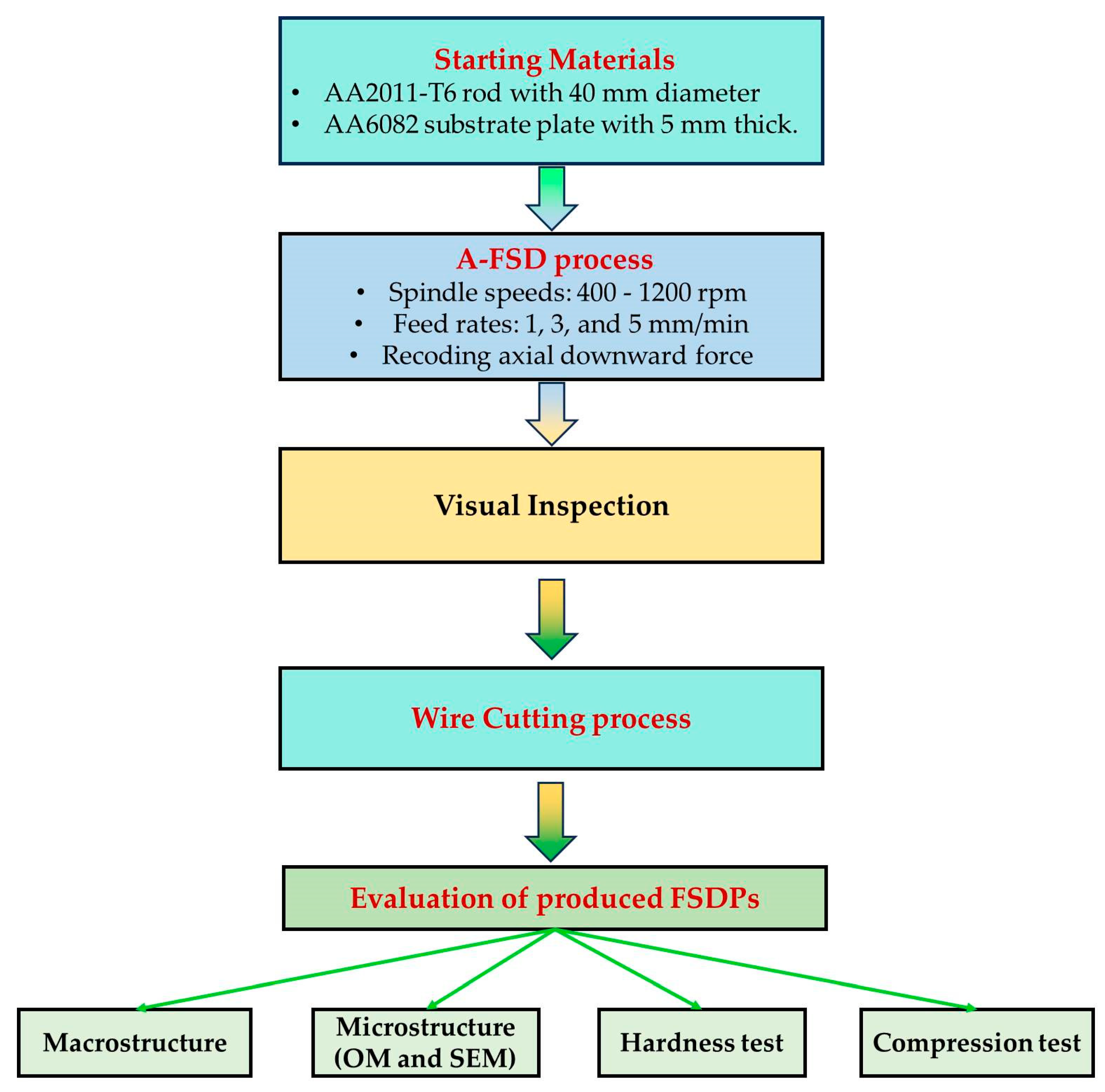
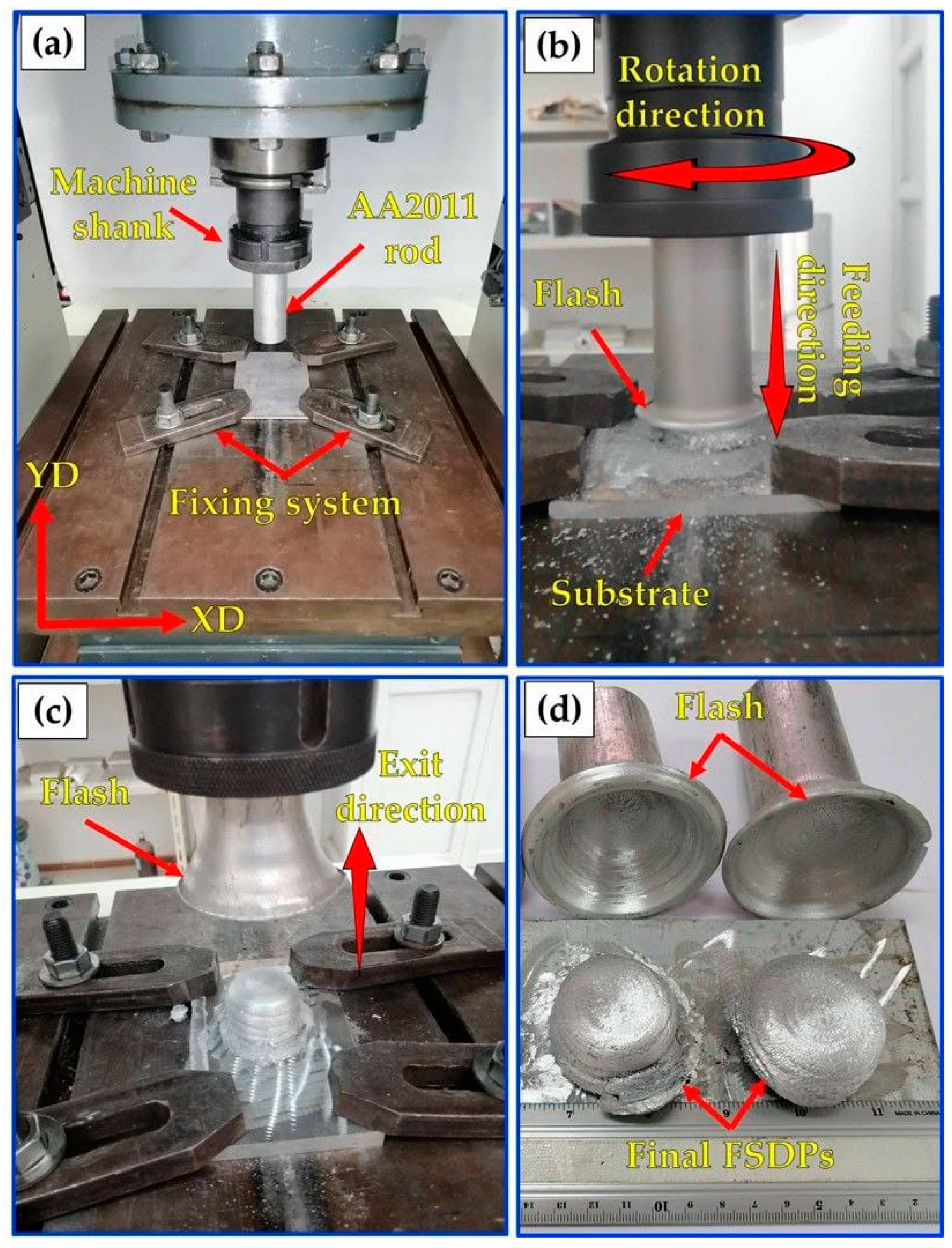
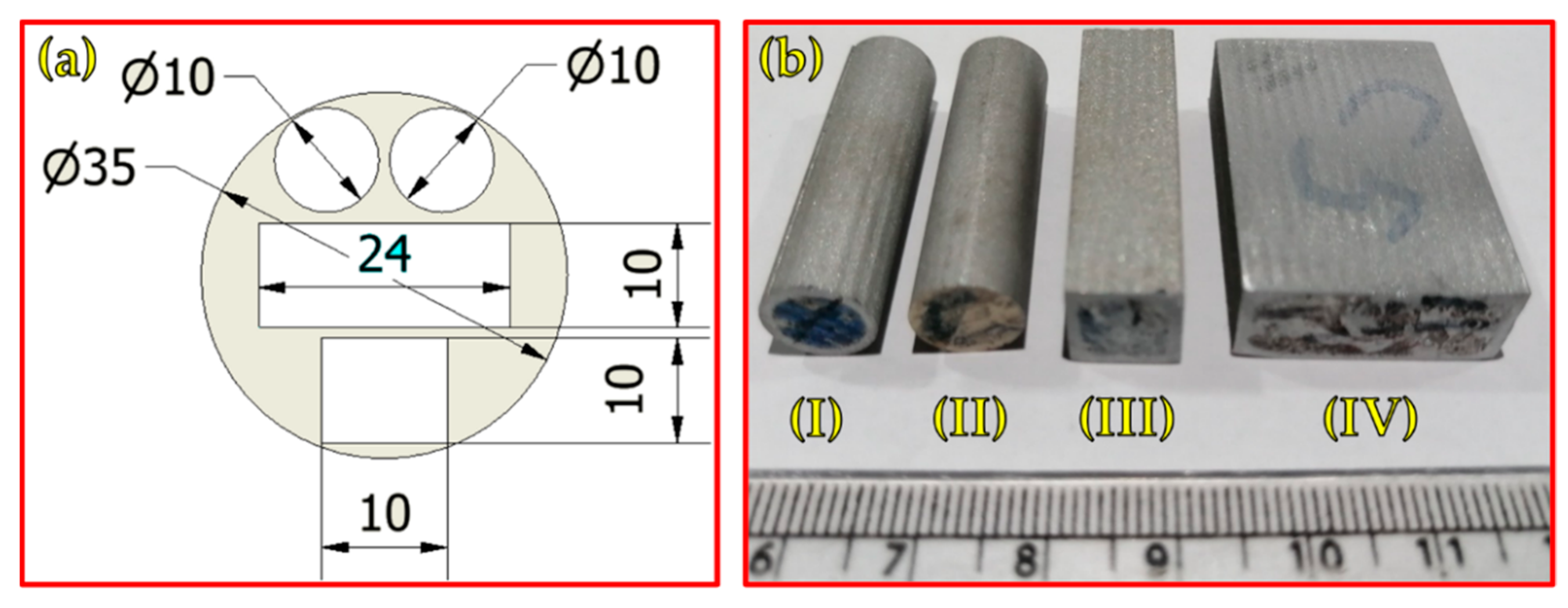
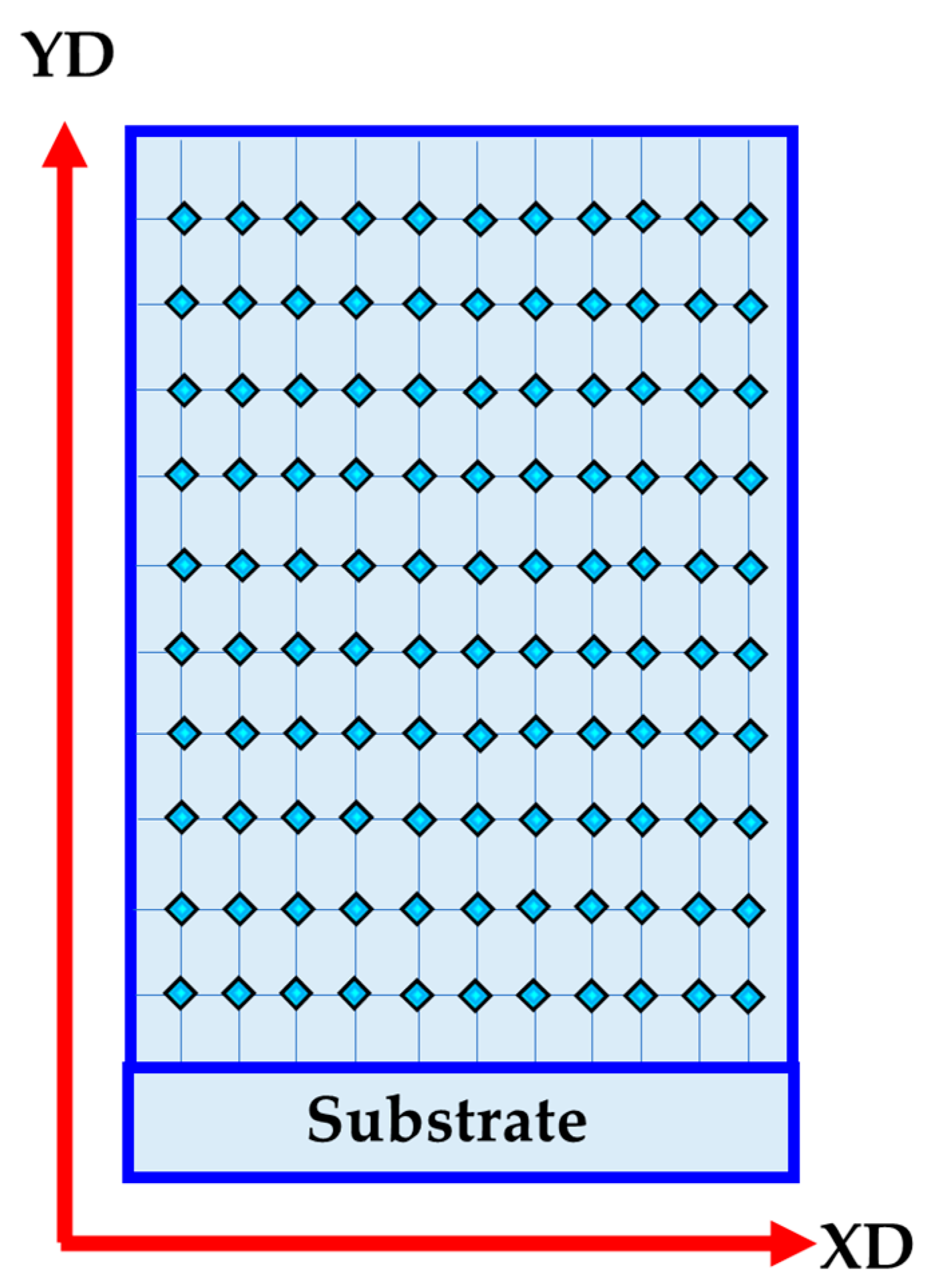
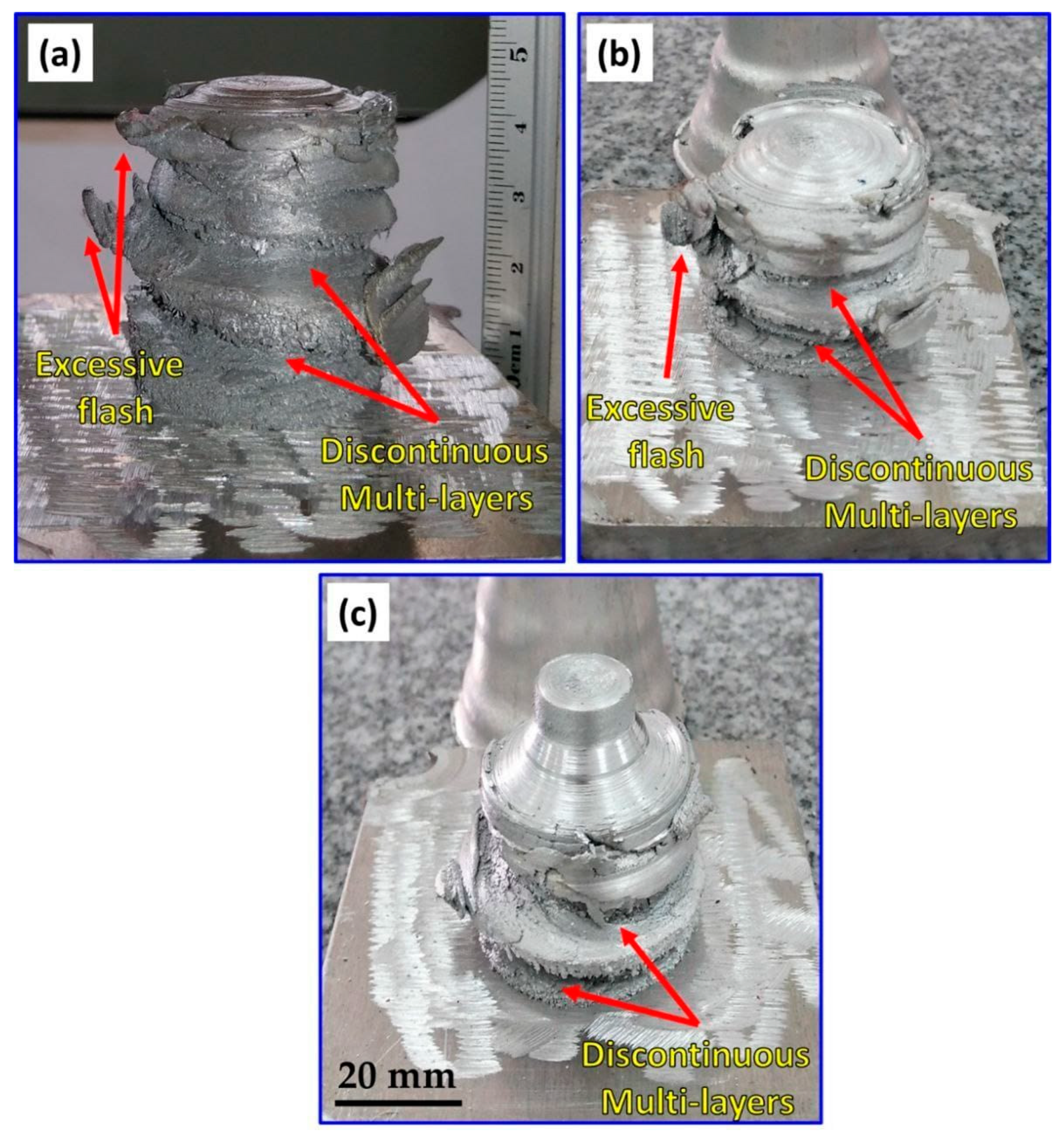
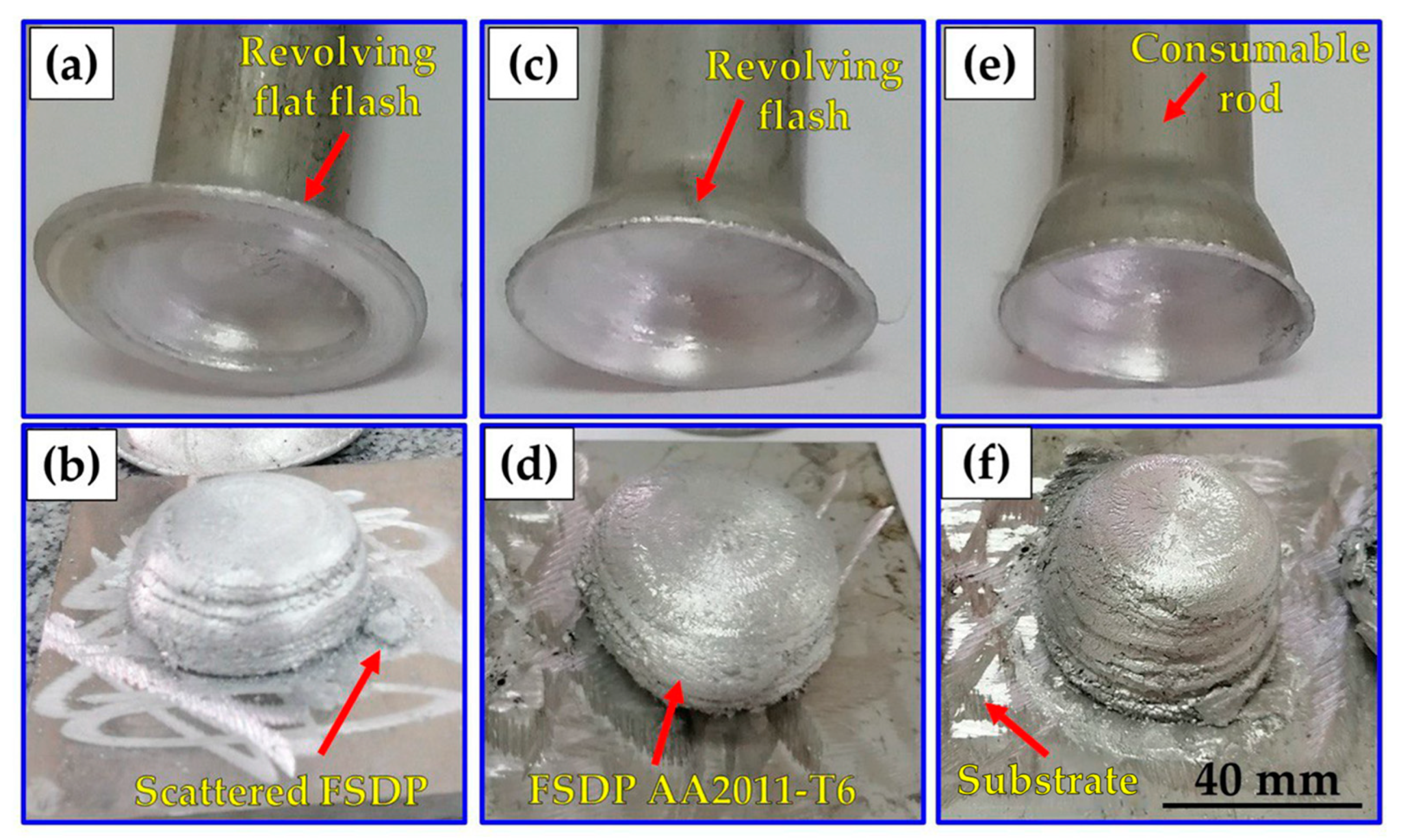
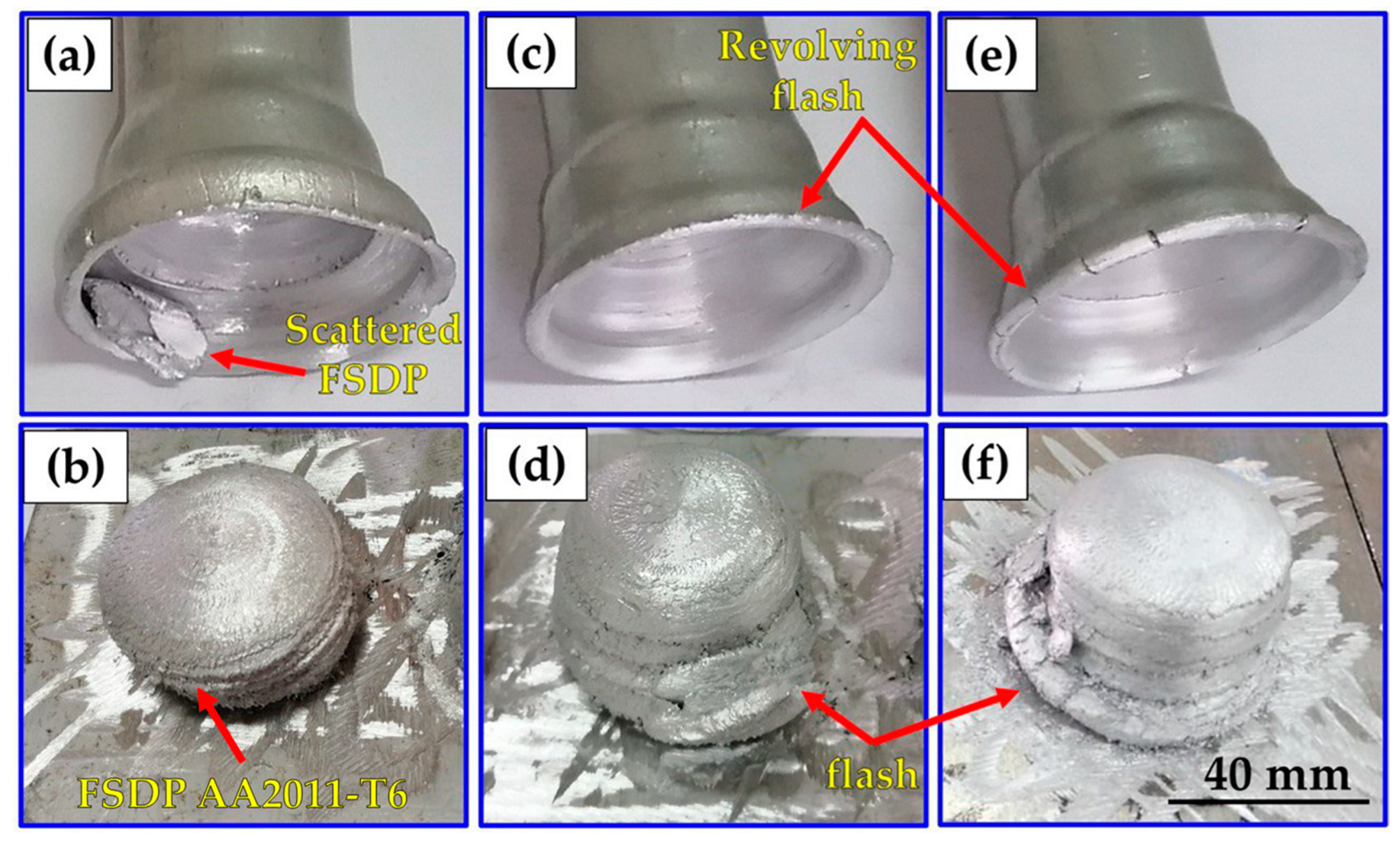
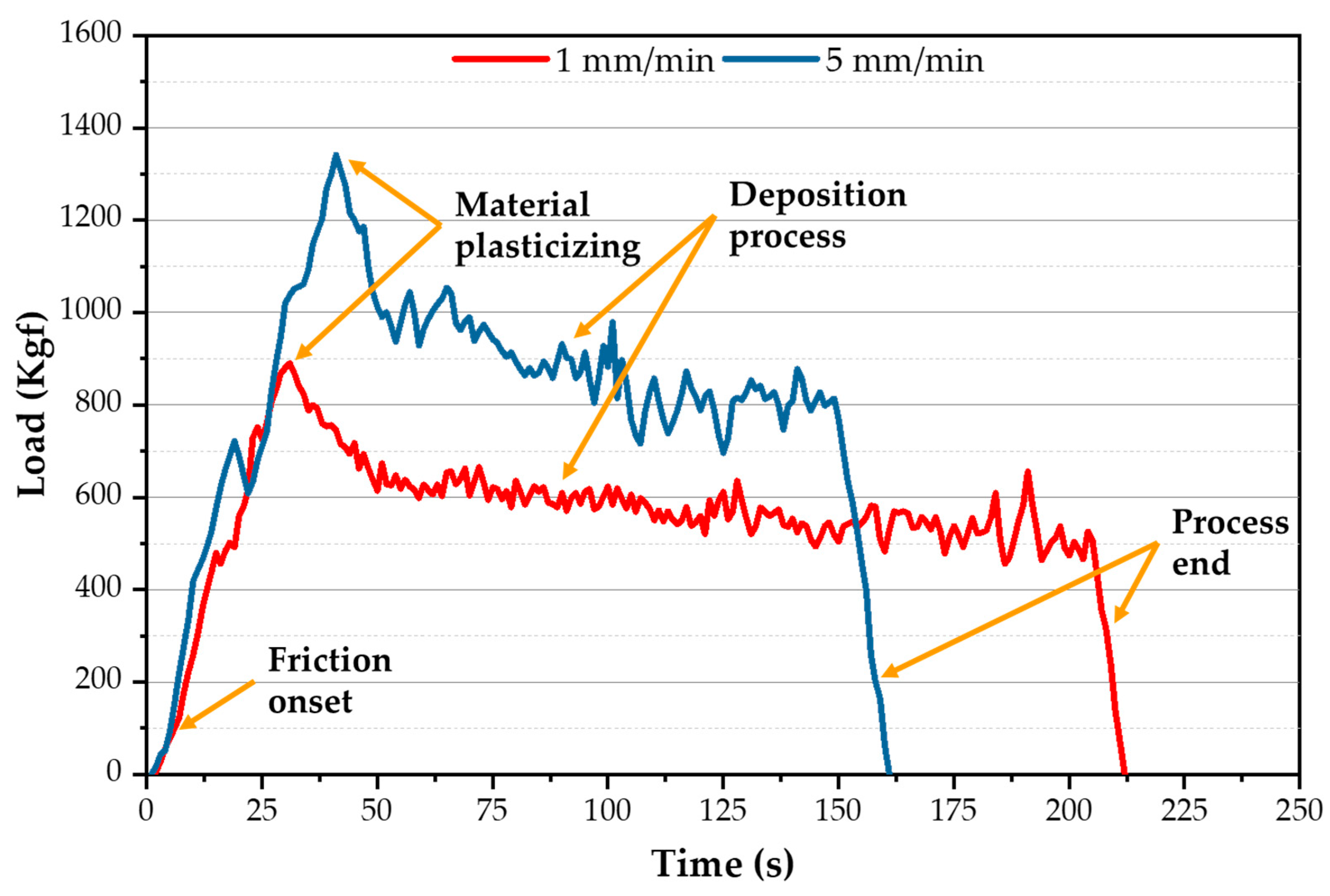
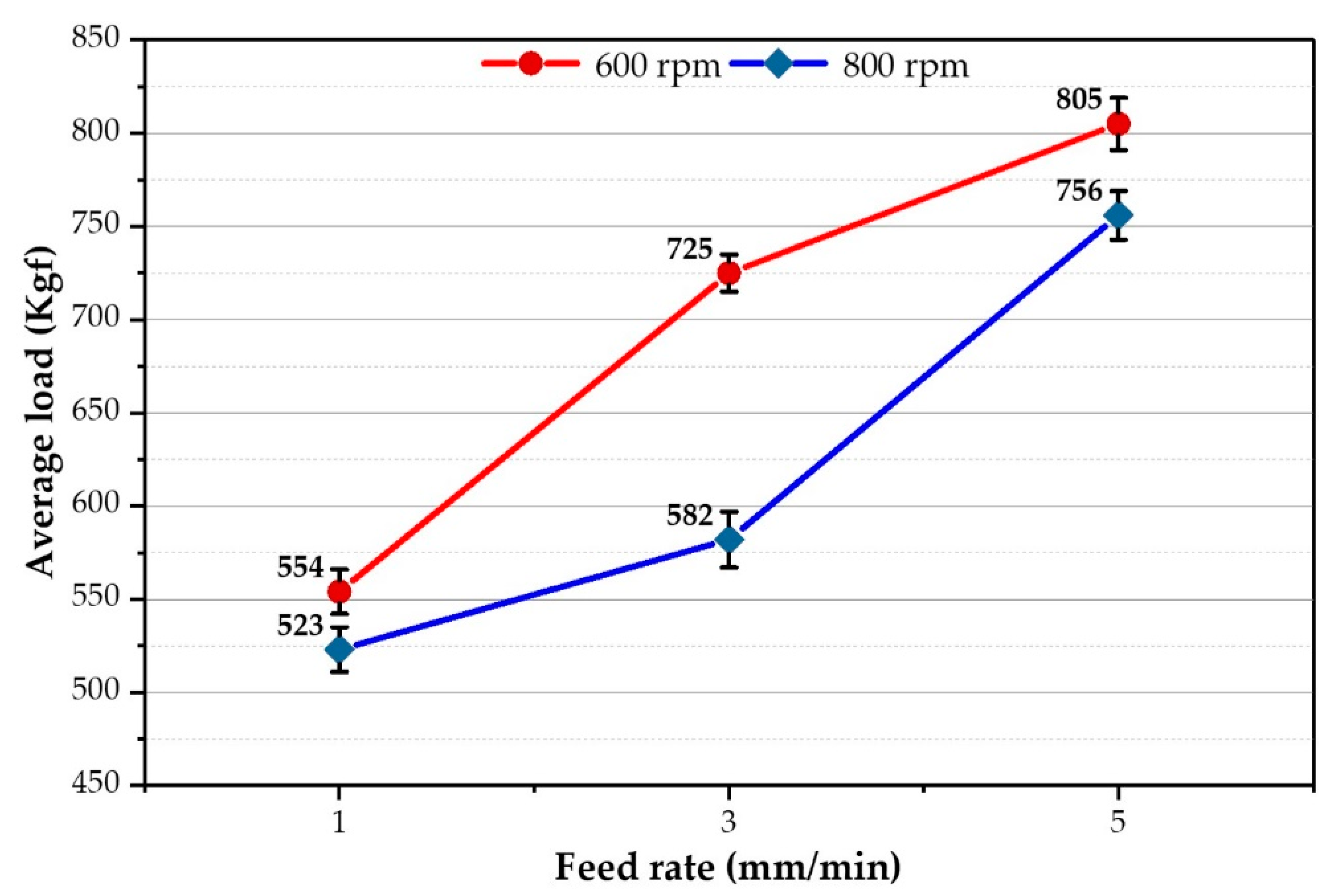
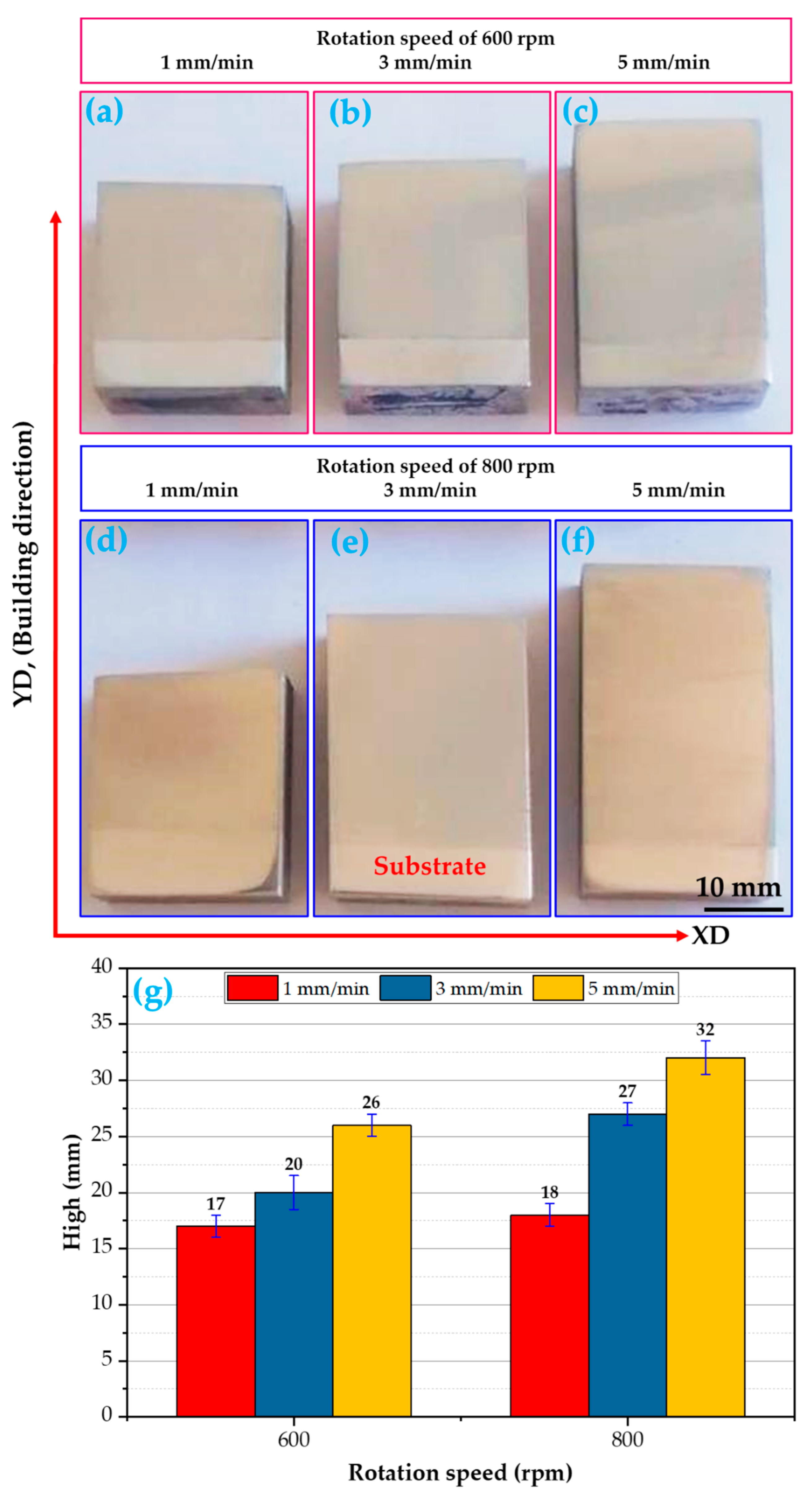
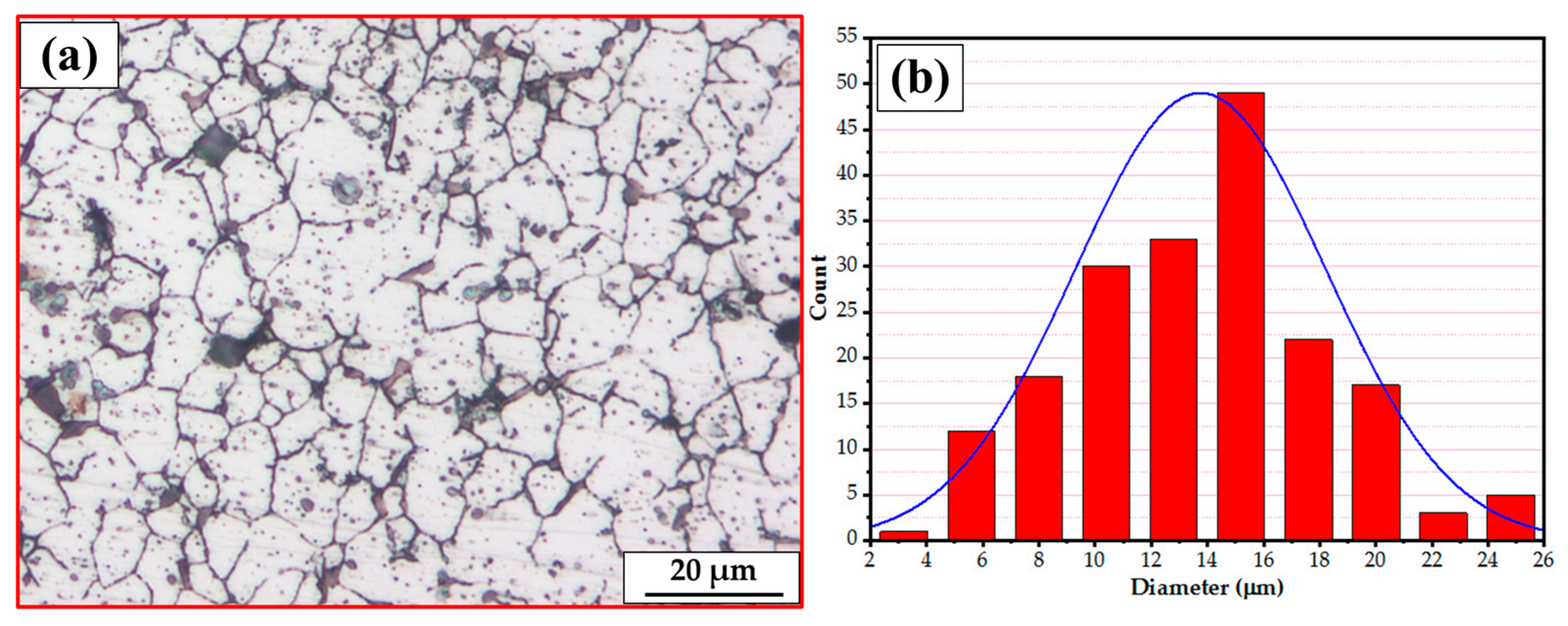
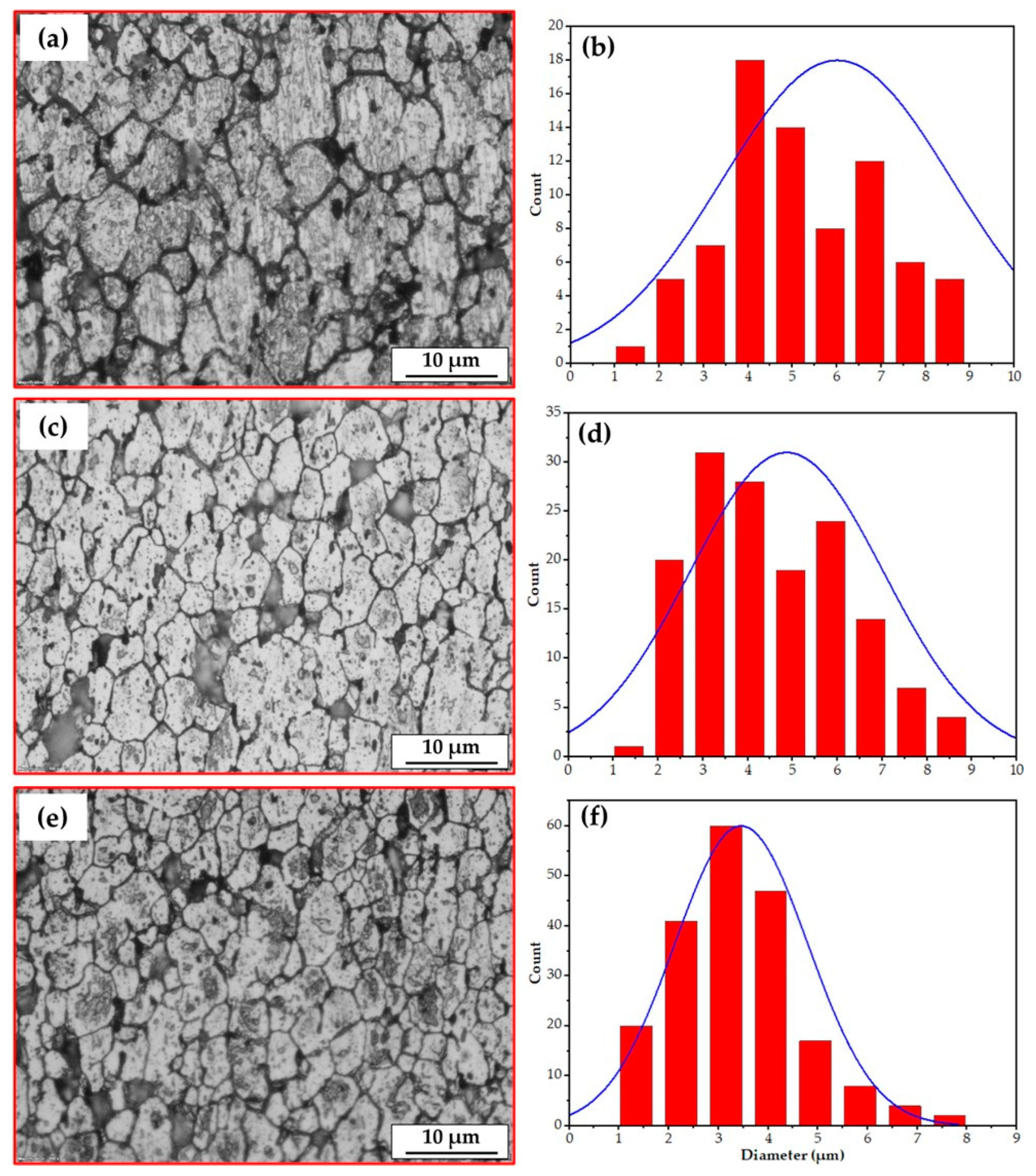
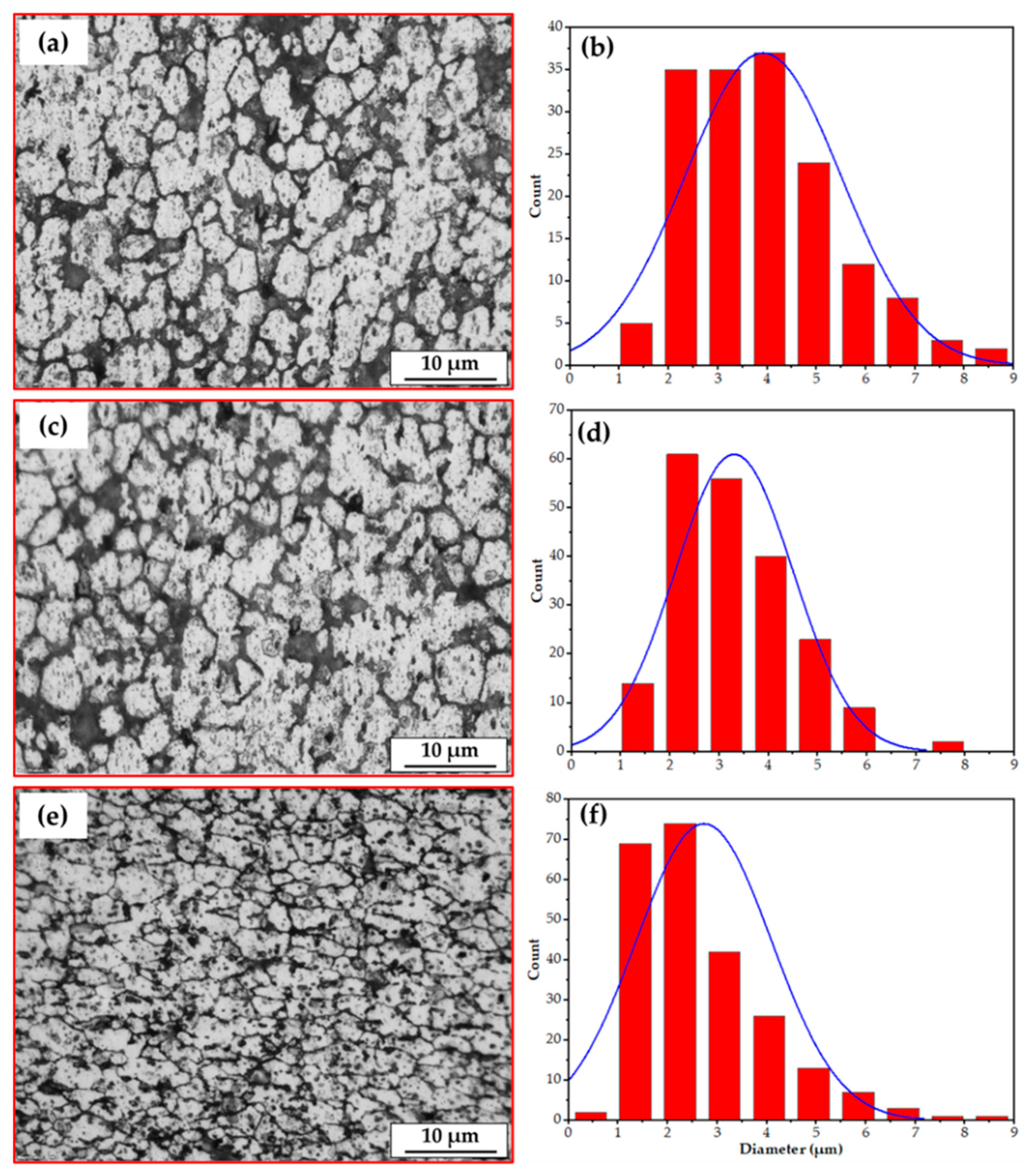
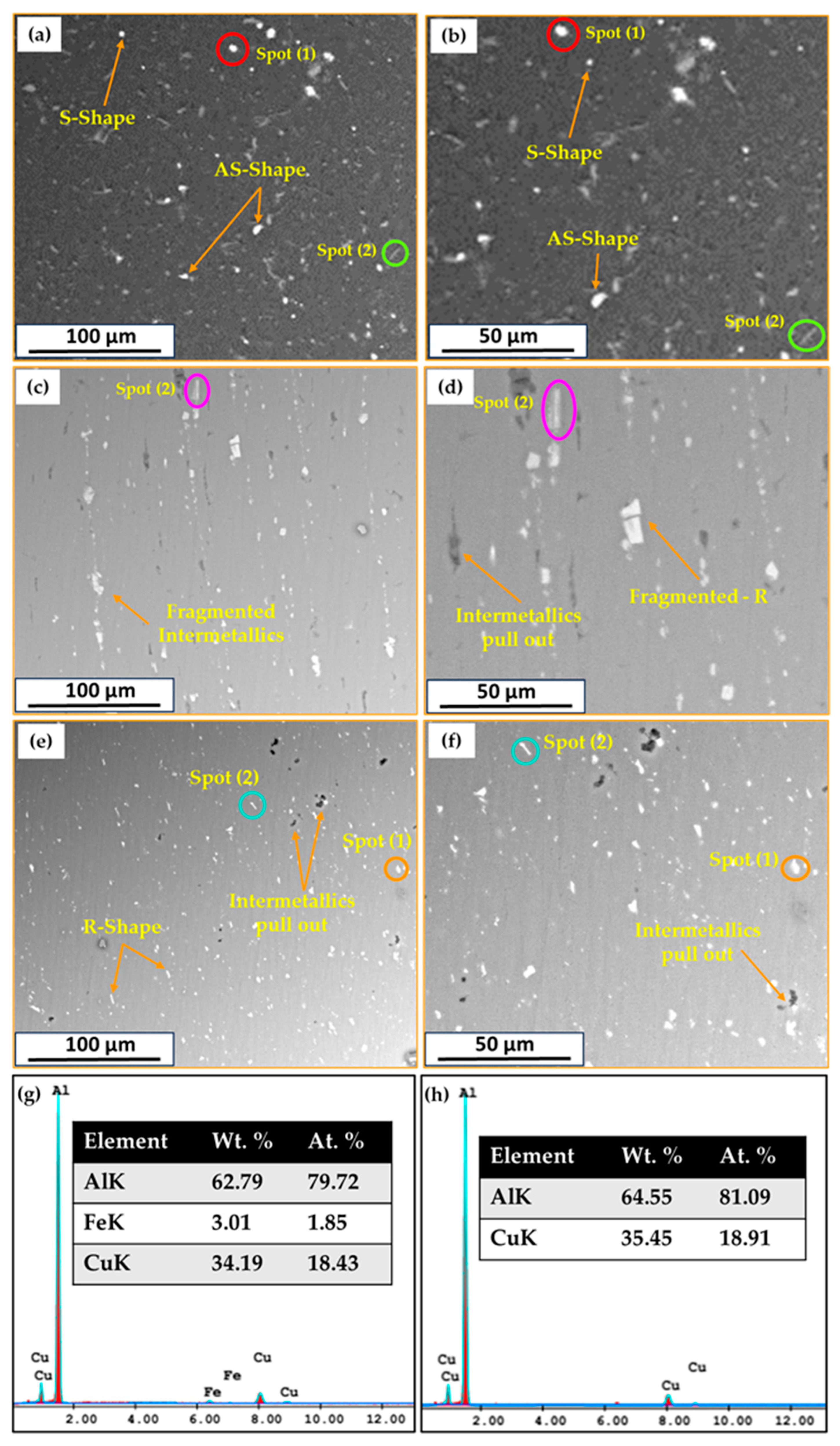
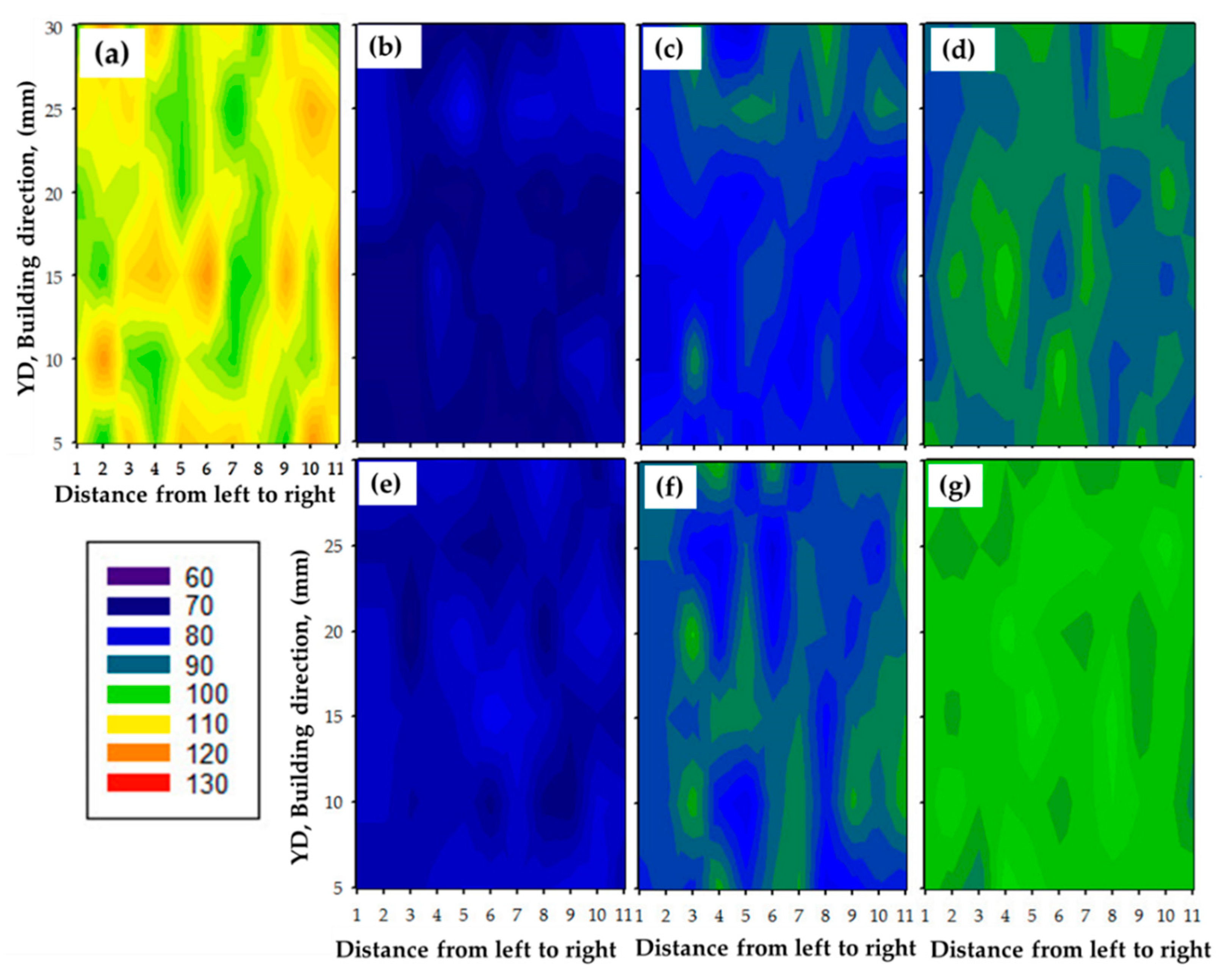
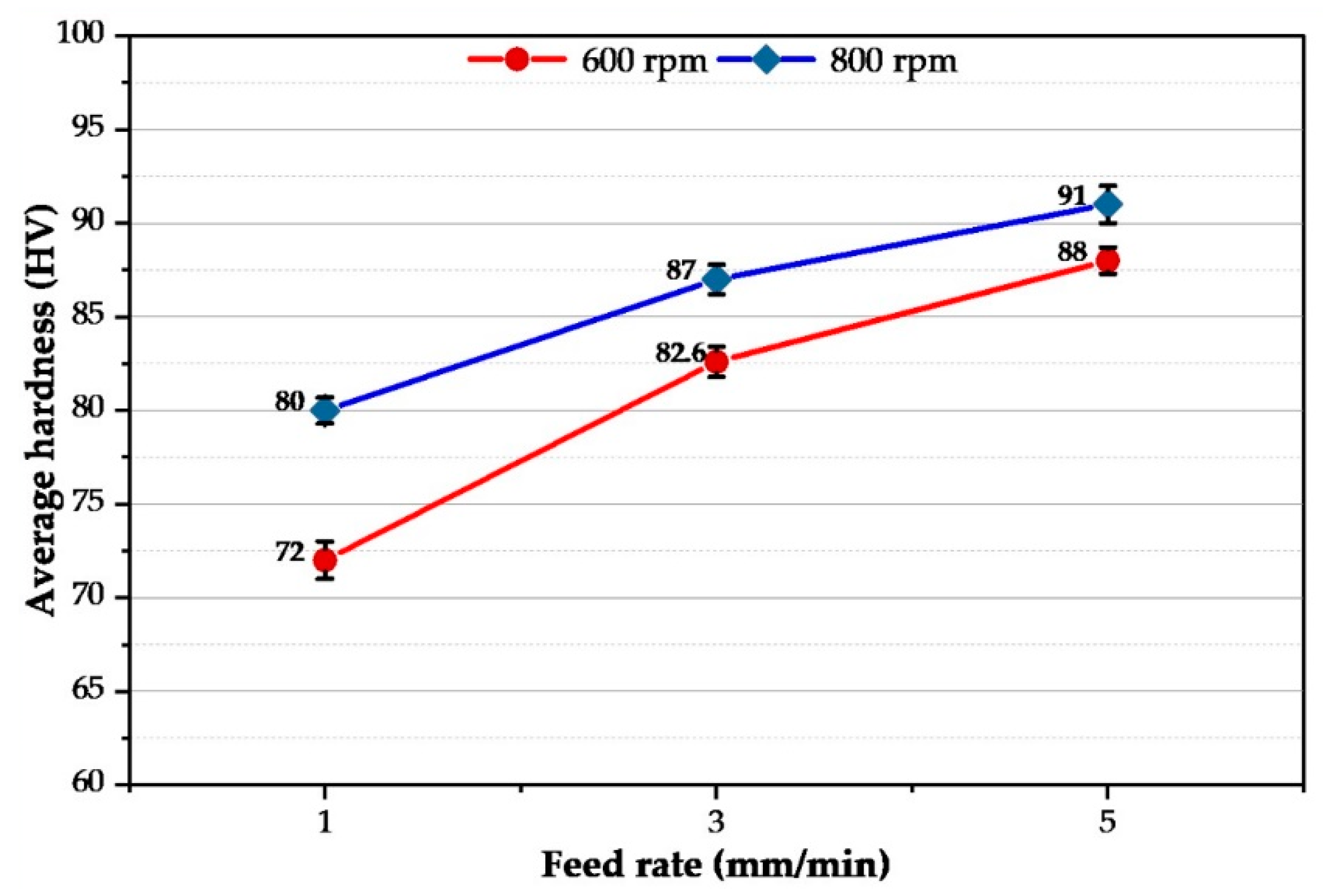
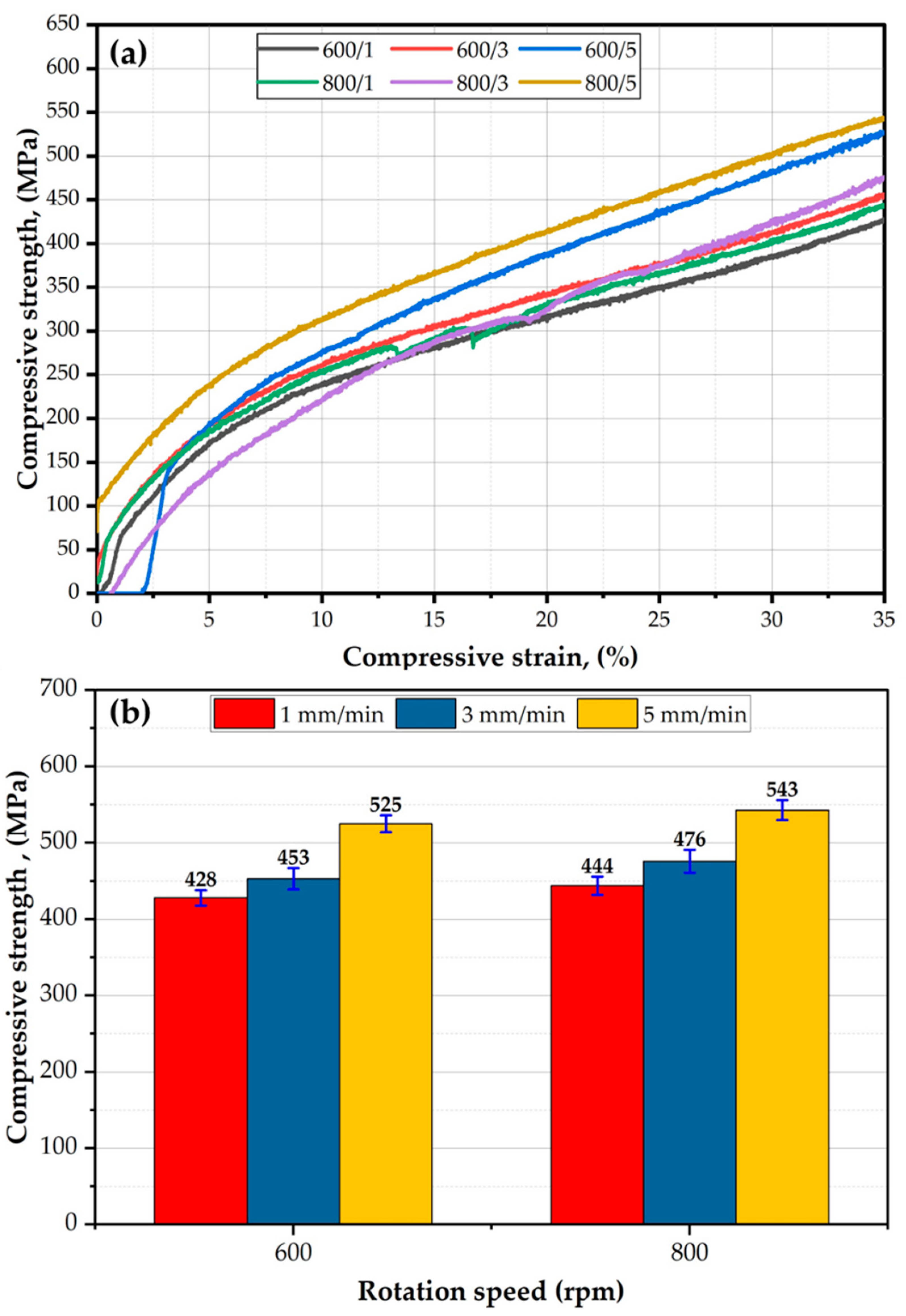
| AA2011-T6 | |||||||||
|---|---|---|---|---|---|---|---|---|---|
| Elements | Cu | Si | Fe | Ti | Bi | Zn | Pb | Ni | Al |
| wt.% | 5.12 | 0.39 | 0.70 | 0.31 | 0.22 | 0.24 | 0.20 | 0.04 | Bal. |
| AA6082-T6 | |||||||||
| Element | Mg | Mn | Cu | Zn | Bi | Si | Fe | Ni | Al |
| wt.% | 0.83 | 0.57 | 0.05 | 0.04 | 0.03 | 0.84 | 0.26 | 0.01 | Bal. |
| No. | Specimen Dimensions (mm) | Test |
|---|---|---|
| 1 | × 15 | Compression |
| 2 | 10 × 10 × 5 | Optical microstructure |
| 3 | 10 × 10 × 5 | SEM investigation |
| 4 | 25 × 10 × 32 | Hardness and macrostructure |
| No | Intermetallics | Morphology | Abbreviation | Chemical Composition (wt.%) |
|---|---|---|---|---|
| 1 | Al2Cu | Spherical | S | 64.55% Al and 35,45 % Cu (Figure 14h) |
| Almost spherical | A–S | |||
| Irregular | I | |||
| 2 | Al7Cu2Fe | Rod-like | R | 62.79% Al, 34.19% Cu, and 3.01% Fe (Figure 14g) |
Disclaimer/Publisher’s Note: The statements, opinions and data contained in all publications are solely those of the individual author(s) and contributor(s) and not of MDPI and/or the editor(s). MDPI and/or the editor(s) disclaim responsibility for any injury to people or property resulting from any ideas, methods, instructions or products referred to in the content. |
© 2023 by the authors. Licensee MDPI, Basel, Switzerland. This article is an open access article distributed under the terms and conditions of the Creative Commons Attribution (CC BY) license (https://creativecommons.org/licenses/by/4.0/).
Share and Cite
Alsaleh, N.A.; El-Sayed Seleman, M.M.; Hassan, A.M.M.; Ahmed, M.M.Z.; Ataya, S.; Latief, F.H.; Abdul-Latif, A.; Habba, M.I.A. Additively Manufactured Parts from AA2011-T6 Large-Diameter Feedstocks Using Friction Stir Deposition. Materials 2023, 16, 4904. https://doi.org/10.3390/ma16144904
Alsaleh NA, El-Sayed Seleman MM, Hassan AMM, Ahmed MMZ, Ataya S, Latief FH, Abdul-Latif A, Habba MIA. Additively Manufactured Parts from AA2011-T6 Large-Diameter Feedstocks Using Friction Stir Deposition. Materials. 2023; 16(14):4904. https://doi.org/10.3390/ma16144904
Chicago/Turabian StyleAlsaleh, Naser A., Mohamed M. El-Sayed Seleman, Ahmed M. M. Hassan, Mohamed M. Z. Ahmed, Sabbah Ataya, Fahamsyah H. Latief, Akrum Abdul-Latif, and Mohamed I. A. Habba. 2023. "Additively Manufactured Parts from AA2011-T6 Large-Diameter Feedstocks Using Friction Stir Deposition" Materials 16, no. 14: 4904. https://doi.org/10.3390/ma16144904
APA StyleAlsaleh, N. A., El-Sayed Seleman, M. M., Hassan, A. M. M., Ahmed, M. M. Z., Ataya, S., Latief, F. H., Abdul-Latif, A., & Habba, M. I. A. (2023). Additively Manufactured Parts from AA2011-T6 Large-Diameter Feedstocks Using Friction Stir Deposition. Materials, 16(14), 4904. https://doi.org/10.3390/ma16144904









